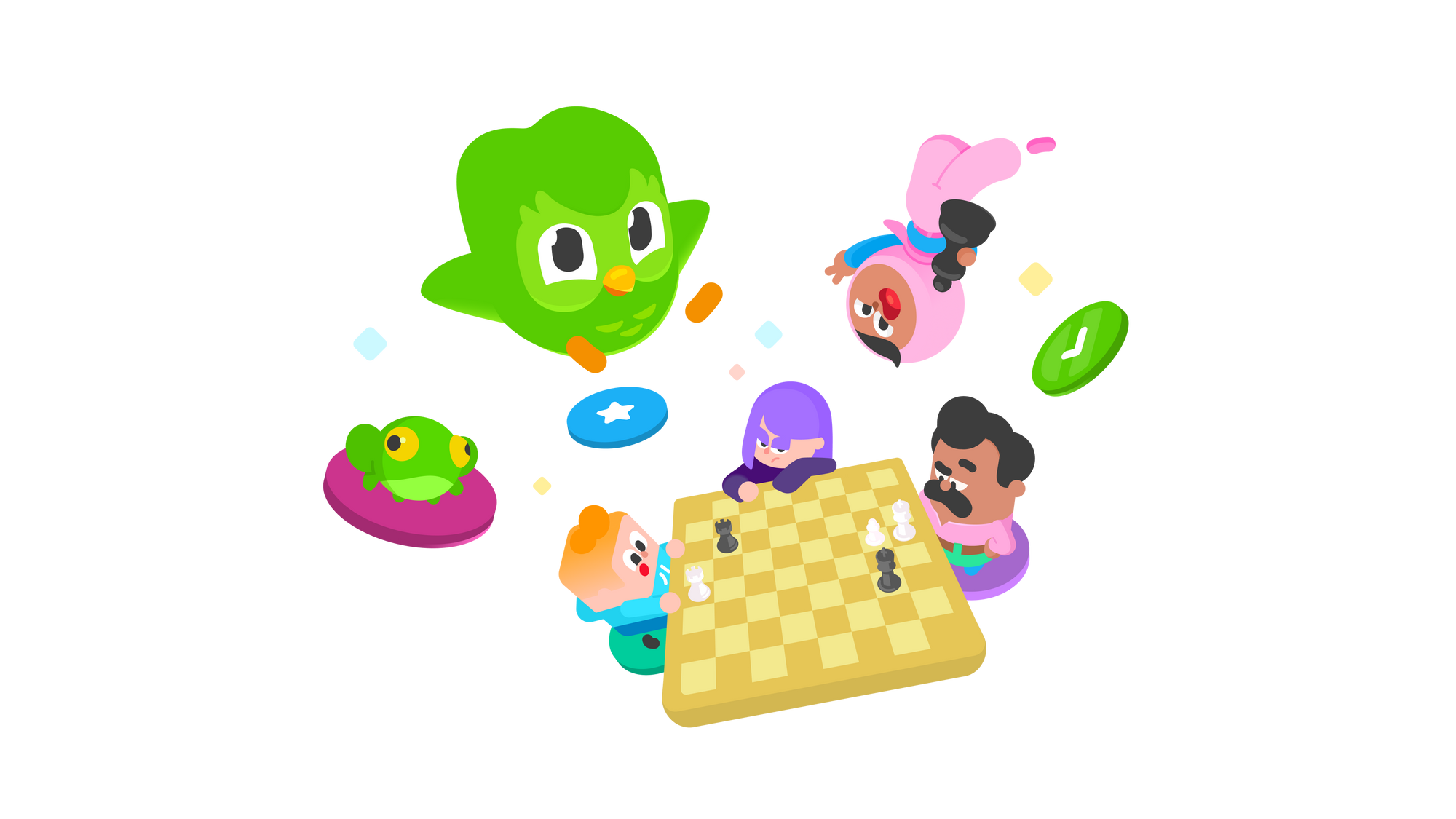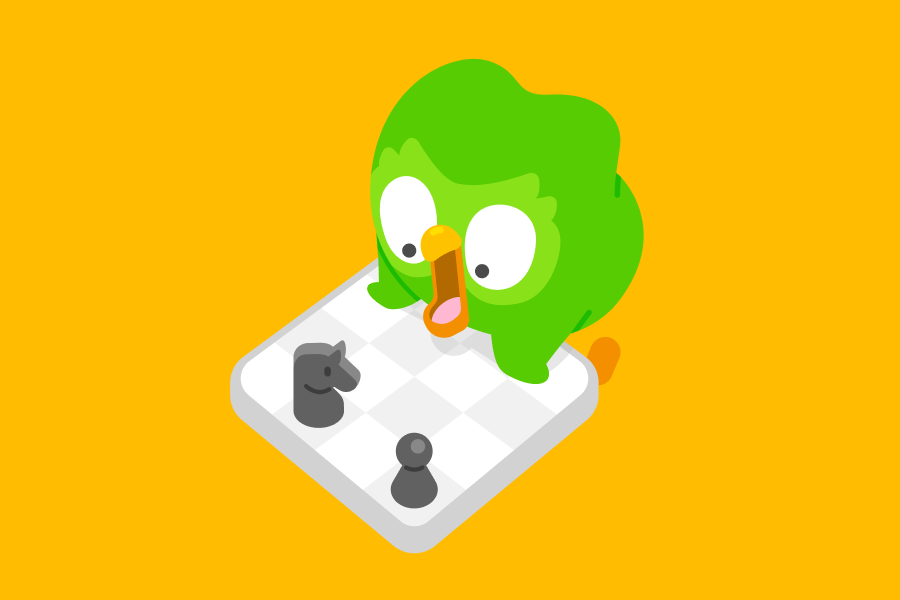If you’re learning chess on Duolingo, you know how many languages are involved: en passant comes from French, German gives us super fast blitz matches, and the bishop’s fianchetto move comes from Italian.
But there’s a lot more where that came from! The long history of chess is a history of language and linguistic change, too. All you have to do is listen closely…

In this post:
- The origins of the word chess
- The history behind the names of chess pieces
- How to say chess, check, and checkmate in different languages
- The names of the chess pieces in different languages
Where does the word “chess” come from?
Not surprisingly, the history of the English name chess all starts with a king: the Persian shah! Today, we pronounce that word in English as “sha,” since even though we have the “h” sound in English (like in happy), we don’t pronounce “h” at the ends of words—but other languages have different rules, and in Persian, you pronounce the “h” at the end of shah.
The Persian word was adopted into Arabic as the name of the king playing piece, and when the game made it to Europe, shah evolved in 2 ways. First, its meaning expanded to refer to the whole game and not just the one piece. Second, it underwent an important sound change. In many European languages, the “h” at the end of shah was replaced with a similar sound also made at the back of the throat: the “k” sound. What was once shah became more like shak, and this evolved into the older French words eschec (check) and eschecs (plural name for all the pieces). The plural name is the one that was borrowed into English as chess!
Other languages got the name of the game from a different source: the Sanskrit name chaturanga. Today, this word can be used for a whole category of chess-like board games that evolved their own forms in cultures around the world. Chaturanga might also sound familiar to the yogis among you—it’s the same word as the four-limbed yoga plank pose!
In both cases, chaturanga means “four parts” or "four limbs," and the chess meaning traces back to the 4 military branches in India. (More on those below.) Chaturanga was adopted into Persian, then Arabic, and then Spanish and Portuguese, due to the long history of contact between Arabic and Spanish and Portuguese. In each new language, the pronunciation of the word changed slightly to fit the language’s sound patterns, eventually yielding Modern Standard Arabic شطرنج (shattaranj), Spanish ajedrez, and Portuguese xadrez.
Putting sounds in check
The goal of the game is to corner the king (formerly, the shah), and in Persian the expression was “to stump (or surprise) the king”: shah mat. The final -h in this phrase also became pronounced as a “k” sound in French, and then in English we borrowed the word as checkmate—the shah is cornered!
Other sound changes can be seen in other languages. Not all languages have a “sh” sound, so some languages use “s” instead of “sh” in their words for chess, check, and checkmate!
You can see the similarities of the names chess, check, and checkmate when you look at languages from around the world. Take a look at the list at the end of this post!
Where do the names of chess pieces come from?
Chess piece names have similarly complex, layered stories that led them to their modern forms. Some pieces started as representing the chaturanga—4 parts—of the army: infantry, cavalry, troops mounted on elephants, and chariots. Their job was to protect the king!
Pawn
The infantry foot soldiers were represented as the pawns. The English word pawn was adopted from the older French forms poun, peon, and pehon, which simply meant soldiers on foot. Foot soldiers and pawns were allegedly from the poorest classes, which is why some languages use words for “peasant” and “farmer” for these pieces. In fact, the English word peon ultimately comes from the same Latin word as pawn!
Knight
Today’s knights originated as the cavalry—soldiers on horseback. As a result, some languages use the word for the horse instead of the rider for this piece. For example, in Spanish the knight piece is known as a caballo (horse)!
Rook
At some point, the original chariots became what we today know as the rook. The symbol of the rook playing piece has moved quite far from the image of a speedy chariot, and in some languages (including Spanish) the rook is simply known as the “tower” (Spanish: la torre).
The origins of the English word rook are unclear—it’s a word specific to chess! The English and Old French words came from Arabic rukhkh, which was rukh in Persian… but no one knows what it meant back then!
We can see more evidence of this mysterious word in other languages as well, particularly in their word for castling. This play involves a king and rook moving at the same time, so some languages have a rukh-inspired word for castling: For example, it’s rochieren (to castle) in German, even though the word for “rook” is Turm (tower)!
Bishop
But it’s the bishop that’s undergone the most dramatic changes—both linguistically and for the shape of the playing piece. This piece once represented the elephant-mounted troops and took the form of an elephant on the chess board. Some languages still use elephant words today! Russian uses the regular Russian word for “elephant,” слон (slon). The Spanish (alfil) and Italian (alfiere) words for the bishop come from the Arabic word for elephant (فيل, fil), which itself came from the Persian word for this animal (pil).
So how did it become “bishop,” anyway? After its start as a soldier-carrying elephant, the piece took on the persona of other intimidating beings: crocodiles, hunters, and archers. But in some chess traditions, it became a messenger, officer, or runner. A Scottish chess set from the 1100s includes this piece as a mini clergyman (really, a little man!), but the first written evidence of the piece being called specifically a “bishop” comes from Icelandic (biskup). By the 1500s, English texts also called the piece bishop. This reference also shows up in the Portuguese name for the piece, bispo!
Queen
The queen is another piece that has evolved over time. In chess’s ancestor, chaturanga, there was no queen. Instead, the king was accompanied by a (male) counselor called mantri (which meant “counselor” or “minister”). This term was later adopted into Persian as farzin and shortened to ferz.
We don’t know exactly why the ferz eventually became a queen, but it likely had to do with the increasing popularity and evolution of chess in the Western world. Interestingly, in some languages, like Russian and Ukrainian, the queen is still called ferz today! Check out the list below to see what chess pieces are called around the world.
You’ve been promoted to queen (of language change)!
Now that you know the linguistic side of chess, it’s time to make your move. Whether you’re a complete beginner or already advanced—you can learn to play chess on Duolingo!
Names for “chess” around the world
| Chess | Check | Checkmate | |
|---|---|---|---|
| Arabic | شطرنج (shattaranj) |
كش (kesh) |
كش ملك (kesh malek) |
| Chinese | 国际象棋 or 西洋棋 (guó jì xiàng qí or xī yáng qí) |
将军 (jiāng jūn) |
将死 (jiāng sǐ) |
| Czech | šachy | šach | šachmat |
| French | échecs | échec | échec et mat |
| German | Schach | Schach | Schachmatt |
| Greek | σκάκι (skáki) |
σαχ (sah) |
ματ (mat) |
| Hindi | शतरंज (shatranj) |
शह (shah) |
(शह) मात (shah maat) |
| Hungarian | sakk | sakk | sakk-matt |
| Italian | scacchi | scacco | scacco matto |
| Japanese | チェス (chesu) |
チェック (chekku) |
チェックメイト (chekkumeito) |
| Korean | 체스 (cheh-su) |
체크 (cheh-ku) |
체크메이트 (cheku-meh-ih-tu) |
| Persian | شطرنج (shatranj) |
كيش (kish) |
مات (mot) |
| Polish | szachy | szach | szach-mat |
| Portuguese | xadrez | xeque | xeque-mate |
| Russian | шахматы (shakhmaty) |
шах (shakh) |
шах и мат (shakh i mat) |
| Spanish | ajedrez | jaque | jaque mate |
| Thai | หมากรุก (maak ruk) |
รุก (ruk) |
รุกจน (ruk jon) |
| Turkish | satranç | şah | şah mat |
Names for chess pieces around the world
| Pawn | Knight | Rook | Bishop | King | Queen | |
|---|---|---|---|---|---|---|
| Chinese | 兵 | 马 | 车 | 象 | 王 | 后 |
| French | pion | cavalier | tour | fou | roi | dame |
| German | Bauer | Springer | Turm | Läufer | König | Dame |
| Hindi | प्यादा | नाइट | रूक | बिशप | किंग | क्वीन |
| Italian | pedone | cavallo | torre | alfiere | re | regina |
| Japanese | ポーン(歩) | ナイト(馬) | ルーク(塔) | ビショップ(僧正) | キング(王) | クイーン(女王) |
| Korean | 폰 (pon) |
나이트 (na-ih-tu) |
룩 (ruk) |
비숍 (bi-shyop) |
킹 (king) |
퀸 (kwin) |
| Portuguese | peão | cavalo | torre | bispo | rei | dama |
| Spanish | peón | caballo | torre | alfil | rey | reina (or dama) |
